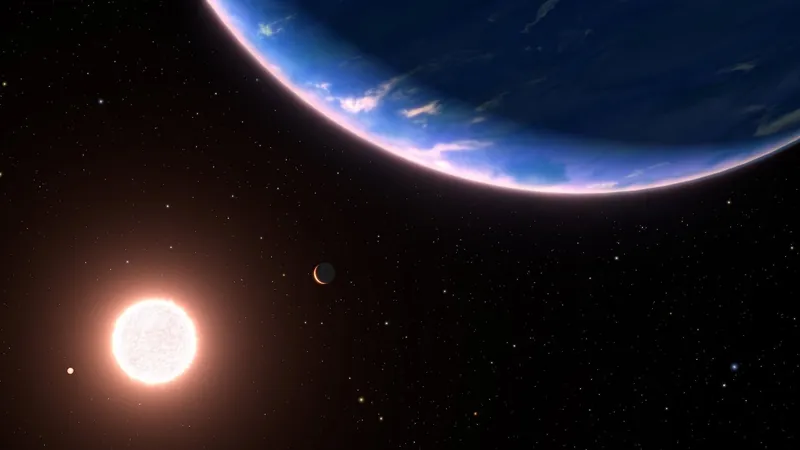
Hubble Telescopes Reveals Water Vapor Mystery on Exoplanet GJ 9827d: What This Could Mean for Alien Life!
2024-12-29
Author: Wei
Introduction
Astronomers utilizing the renowned NASA/ESA Hubble Space Telescope have made an exciting discovery—the detection of water vapor in the atmosphere of the small exoplanet GJ 9827d, cataloged as the smallest known exoplanet to exhibit this characteristic. GJ 9827d measures just about twice the size of Earth, and this finding could signal that water-rich atmospheres exist on planets orbiting other stars, expanding our understanding of potential extraterrestrial habitats.
Groundbreaking Discovery
"This is a groundbreaking moment as it is the first time that we can demonstrate, through atmospheric evidence, that planets with water-rich atmospheres may indeed orbit other stars," said Björn Benneke from the Université de Montréal, a member of the research team. "Determining the prevalence and diversity of atmospheres on rocky planets is crucial in our quest to understand the cosmos."
Ambiguities Remain
However, the findings come with intriguing ambiguities. It remains unclear whether the Hubble observations indicate a significant presence of water vapor within a fluffy, hydrogen-rich atmosphere, or if GJ 9827d's environment is predominantly water, a remnant after an earlier epoch when a hydrogen/helium atmosphere was stripped away by stellar radiation.
Observation Program
"Our observational program aimed not just to detect atmospheric molecules but specifically to identify water vapor," explained Pierre-Alexis Roy, the lead author of the study. "Whether water vapor is a dominant component or merely a trace within a hydrogen-heavy atmosphere is still exciting."
Inhospitable Conditions
At a scorching temperature of approximately 425 degrees Celsius, GJ 9827d is reminiscent of Venus in its inhospitable conditions. If its atmosphere is indeed rich in water vapor, it would make for a steamy, hostile environment.
Atmospheric Origins
Research indicates two possible origins for this planet's atmospheric composition. One theory suggests that GJ 9827d retains a hydrogen-rich atmosphere that is laced with water, categorizing it as a mini-Neptune. Alternatively, it might resemble Jupiter's moon Europa, which is believed to harbor an ocean beneath its icy surface—"GJ 9827d could be a unique blend of rock and water, potentially half water and half rock," notes Benneke.
Formation and Migration
Intriguingly, if this planet once hosted a water-rich atmosphere, it likely formed at a greater distance from its star—where temperatures would allow water to coexist as ice—before migrating inward, closer to its star, and experiencing increased radiation that may have led to the escape of its hydrogen envelope.
Hubble Observations
To confirm these findings, the Hubble team conducted observations during 11 transiting events over three years, allowing them to analyze starlight filtered through the atmosphere of GJ 9827d, thus identifying the spectral fingerprints of water molecules. Thankfully, even if clouds are present, they do not entirely obscure Hubble’s observations, enabling the detection of water vapor just above the clouds.
Future Research Opportunities
"The discovery opens up new avenues for research," said Roy. The upcoming NASA/ESA/CSA James Webb Space Telescope can leverage this data to delve deeper into the atmospheric compositions of GJ 9827d—searching for additional molecules that could hint at the planet’s atmospheric history.
Conclusion
GJ 9827d was initially discovered by the Kepler Space Telescope in 2017. It orbits a red dwarf star named GJ 9827 every 6.2 days and is located an intriguing 97 light-years away from Earth in the constellation Pisces. With this remarkable breakthrough, the quest to identify potential habitable worlds continues, bringing humanity one step closer to answering the ultimate question: Are we alone in the universe?

 Brasil (PT)
Brasil (PT)
 Canada (EN)
Canada (EN)
 Chile (ES)
Chile (ES)
 Česko (CS)
Česko (CS)
 대한민국 (KO)
대한민국 (KO)
 España (ES)
España (ES)
 France (FR)
France (FR)
 Hong Kong (EN)
Hong Kong (EN)
 Italia (IT)
Italia (IT)
 日本 (JA)
日本 (JA)
 Magyarország (HU)
Magyarország (HU)
 Norge (NO)
Norge (NO)
 Polska (PL)
Polska (PL)
 Schweiz (DE)
Schweiz (DE)
 Singapore (EN)
Singapore (EN)
 Sverige (SV)
Sverige (SV)
 Suomi (FI)
Suomi (FI)
 Türkiye (TR)
Türkiye (TR)
 الإمارات العربية المتحدة (AR)
الإمارات العربية المتحدة (AR)